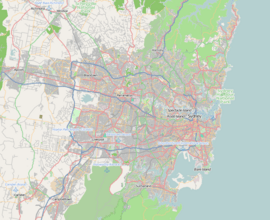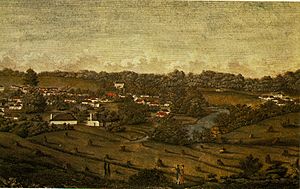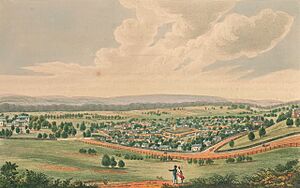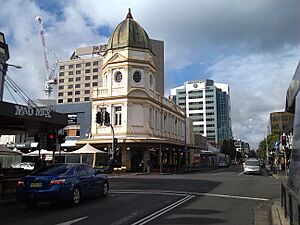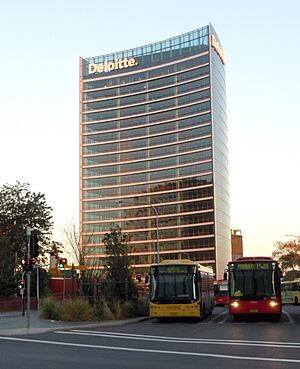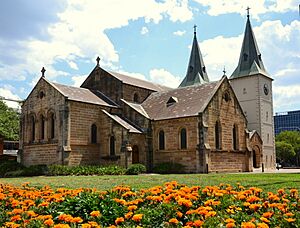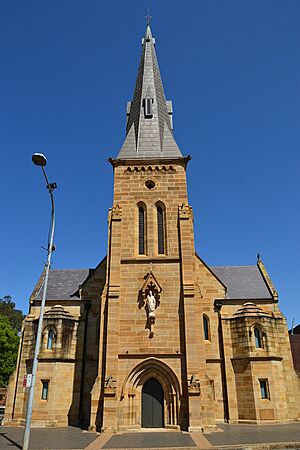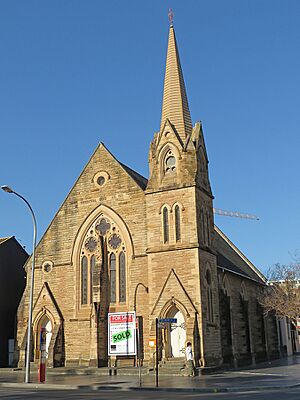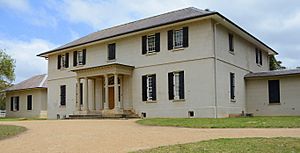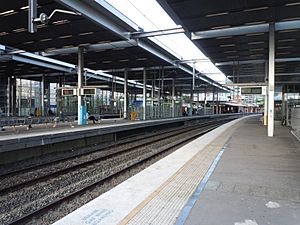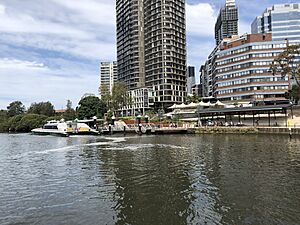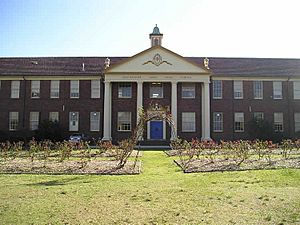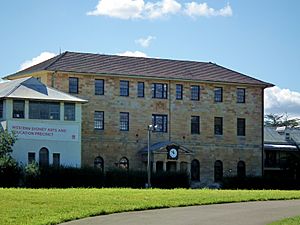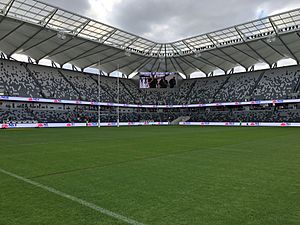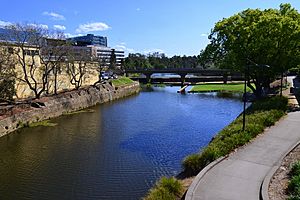Parramatta facts for kids
Quick facts for kids ParramattaNew South Wales |
|||||||||||||||
|---|---|---|---|---|---|---|---|---|---|---|---|---|---|---|---|
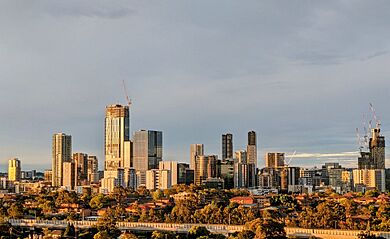
Parramatta viewed from the south in 2022
|
|||||||||||||||
| Population | 30,211 (2021 census) | ||||||||||||||
| • Density | 5,700/km2 (15,000/sq mi) | ||||||||||||||
| Established | 1788 | ||||||||||||||
| Postcode(s) | 2150 | ||||||||||||||
| Elevation | 18 m (59 ft) | ||||||||||||||
| Area | 5.3 km2 (2.0 sq mi) | ||||||||||||||
| Location | 24 km (15 mi) west of Sydney CBD (Central Sydney) | ||||||||||||||
| LGA(s) | City of Parramatta | ||||||||||||||
| Region | Greater Western Sydney Metropolitan area | ||||||||||||||
| County | Cumberland | ||||||||||||||
| Parish | St John | ||||||||||||||
| State electorate(s) |
|
||||||||||||||
| Federal Division(s) | Parramatta | ||||||||||||||
|
|||||||||||||||
Parramatta (/ˌpærəˈmætə/) is a big suburb and an important business area in Greater Western Sydney. It is about 24 kilometers (15 miles) west of the main Sydney city center. Parramatta sits on the banks of the Parramatta River. Many people see it as the second most important city center in Greater Sydney.
Parramatta is the main town for the City of Parramatta local government area. It is one of the key centers in the Greater Sydney region. Other important centers include the Sydney city center, Penrith, Campbelltown, and Liverpool. Parramatta has also been an important government hub for a long time. Many government offices and courts are located here. People often call it "Parra" for short.
Parramatta was started by the British in 1788, the same year as Sydney. This makes it the oldest inland European settlement in Australia. It is also the main economic center for Greater Western Sydney. Since 2000, many government groups like the New South Wales Police Force and Sydney Water have moved their offices to Parramatta from Central Sydney. The 151st meridian east line goes right through the suburb.
Contents
History of Parramatta
First People of Parramatta
People have lived in the Parramatta area for about 30,000 years. This is known from special dating methods. The Darug people lived here before Europeans arrived. They found lots of food from the river and forests. They called the area Baramada or Burramatta. This means "Eel Place" ("Burra" for Eel, "matta" for Place). The local Indigenous people were called the Burramattagal. Other Darug words like Cabramatta (Grub place) and Wianamatta (Mother place) have similar endings.
Even today, many eels and other sea creatures come to this area. They are attracted to the nutrients where the salty water of Port Jackson meets the fresh water of the Parramatta River. The Parramatta Eels rugby league team chose their name because of this.
British Settlement in Parramatta
The British settled Parramatta in 1788, the same year they settled Sydney. This makes Parramatta the second oldest city in Australia. It is only 10 months younger than Sydney. The British colonists arrived in January 1788 at Sydney Cove. They did not have enough food for long. The soil around Sydney Cove was too poor to grow enough food for the 1,000 convicts, soldiers, and leaders.
During 1788, Governor Arthur Phillip looked at several places. He chose Parramatta as the best place for a large farm. Parramatta was the furthest point inland on the Parramatta River that boats could reach. It was also where the river became fresh water, which was good for farming.
On November 2, 1788, Governor Phillip and some marines and a surveyor went upriver. They found a hill shaped like a curve, which he called The Crescent. This spot was easy to defend and was by a river bend. It is now in Parramatta Park. The Burramattagal people were quickly forced off their lands.
As the settlement grew, Governor Phillip named it "Rose Hill." This was after a British politician named George Rose. On June 4, 1791, Phillip changed the town's name to Parramatta. This was closer to the name used by the local Aboriginal people. A nearby suburb later got the name "Rosehill."
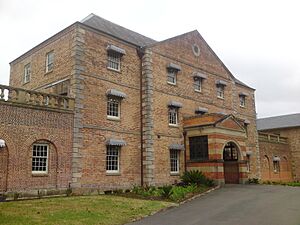
To help with the food shortage, Governor Phillip gave land to a convict named James Ruse in 1789. This land was called Experiment Farm in Parramatta. Ruse had to prove he could grow food successfully. He became the first European to successfully grow grain in Australia. The Parramatta area was also where the Australian wool industry began. This was thanks to John Macarthur's Elizabeth Farm in the 1790s.
A major battle of the Australian frontier wars happened in March 1797. Eora leader Pemulwuy led about 100 Bidjigal warriors in an attack on Parramatta. The soldiers pulled back to their barracks. Pemulwuy held the town until he was shot and hurt.
Governor Arthur Phillip built a small house for himself on The Crescent hill. In 1799, a larger house replaced it. Governor Lachlan Macquarie improved this house from 1815 to 1818. It is now the oldest surviving Government House in Australia. Governors used it as a retreat until the 1850s.
In 1803, a strange event happened in Parramatta. A criminal named Joseph Samuel was sentenced to death by hanging. But the rope broke. On the second try, the noose slipped off his neck. On the third try, the new rope broke. Governor King was called and pardoned Samuel. It seemed like a miracle.
In 1814, Governor Macquarie opened a school for Aboriginal children in Parramatta. This was part of a plan to improve relations between Aboriginal and European communities. This school later moved to "Black Town".
Modern Parramatta
Parramatta officially became a city on November 19, 1976. It became a suburb on June 10, 1994.
Tall buildings started to appear in Parramatta in the late 1990s. The suburb became a major business and living area in the early 2000s. Its growth has sped up even more in the last ten years.
The first part of the Parramatta Light Rail was finished on December 20, 2024.
Climate and Weather
Parramatta has a humid subtropical climate. This means it has mild to cool, short winters. Summers are warm to usually hot. It gets a moderate amount of rain throughout the year.
Summer temperatures can change a lot. They often go above 35°C (95°F). This happens about 13 days in summer. Sometimes, temperatures stay in the low 20s (70s°F), especially after a cold front or a sea breeze. Winds from the northwest can bring hot air from the Australian desert. This can push temperatures above 40°C (104°F) from November to February. The highest temperature recorded since 1967 was 47.0°C (116.6°F) on January 4, 2020.
Parramatta is warmer than the Sydney CBD in summer. This is because of the urban heat island effect and its location further inland. In extreme cases, it can be 5–10°C (9–18°F) warmer than Sydney. This happens when sea breezes do not reach inland on hot summer and spring days. For example, on November 28, 2009, Sydney reached 29.3°C (84.7°F), while Parramatta reached 39.0°C (102.2°F). This was almost 10°C (18°F) higher. In summer, Parramatta can sometimes be one of the hottest places in the world. This is because the Blue Mountains trap hot air in the region.
Rainfall is a bit higher in the first three months of the year. This is because moist easterly winds from the Tasman Sea reach the city. The second half of the year tends to be drier. This is because dry westerly winds from inland Australia are more common. Thunderstorms are common from early spring to early autumn. Sometimes, these storms can be very strong. Snow is almost never seen. It was only recorded in 1836 and 1896. Parramatta gets about 106 clear days each year.
Shopping and Business
Church Street is a busy area with many shops and restaurants. The northern part of Church Street, near Lennox Bridge, has many outdoor dining spots with different types of food. South of the city center, Church Street is known as 'Auto Alley'. This is because of the many car dealerships along the street.
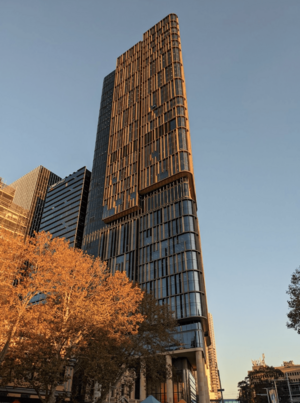
Since 2000, Parramatta has become an even bigger government center. Offices like the New South Wales Police Force Headquarters and Sydney Water Corporation moved here. Big construction projects also happened around the railway station. This included expanding Westfield Shoppingtown and building a new transport hub.
The western part of Parramatta's city center is called the Parramatta Justice Precinct. It holds the main offices for the Department of Communities and Justice. Other legal offices are also here. These include the Children's Court of New South Wales and the Sydney West Trial Courts. The Parramatta Courthouse is nearby. The Garfield Barwick Commonwealth Law Courts Building has courts for federal cases. The NSW Government has also planned to move more workers from the Sydney CBD to Parramatta.
Parramatta Square is a modern area in the city's heart. It is next to Parramatta Town Hall. Construction work at Parramatta Square included new buildings and a plaza. One building, 8 Parramatta Square, became a 55-story office building. It was originally planned to be a taller residential tower. Parramatta Square is now home to 3,000 National Australia Bank employees. Other big companies like Westpac and KPMG also have offices here.
Centenary Square was created in 1975. The council closed a part of the main street to make a pedestrian area. It has an 1888 Centennial Memorial Fountain. It is next to the 1883 Parramatta Town Hall and St John's Cathedral.
Parramatta is a major business and shopping center. It is home to Westfield Parramatta. This is one of the largest shopping centers in Australia. Parramatta is also a big transport hub for Western Sydney. It has trains, buses, a ferry wharf, and new light rail and metro services.
Places of Worship
Church Street gets its name from St John's Cathedral (Anglican). It was built in 1802 and is the oldest church in Parramatta. The towers were built when Governor Macquarie was in charge. The historic St John's Cemetery is also nearby.
St Patrick's Cathedral (Roman Catholic) is one of Australia's oldest Catholic churches. Building started in 1836. A new church was planned in 1854. It was destroyed by fire in 1996, with only the stone walls left. The new St Patrick's Cathedral was opened on November 29, 2003. The historic St Patrick's Cemetery is in North Parramatta.
Parramatta also has a Uniting Church, a Salvation Army building, and the Parramatta and Districts Synagogue for the Jewish community. The Greek Orthodox Church of St Ioannis was started in 1960. It moved to a new location in 2014.
A Buddhist temple is in Cowper Street. Parramatta's Mosque is in an apartment building. There are also Hindu temples nearby, including a BAPS Swaminarayan Hindu temple in Rosehill and a Murugan Hindu temple in Mays Hill.
Parks and Green Spaces
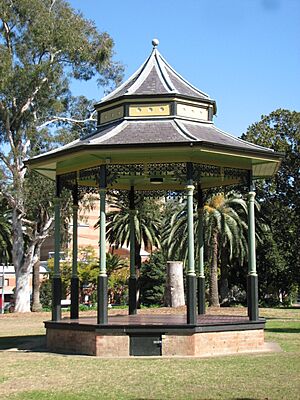
Parramatta Park is a large park next to Western Sydney Stadium. It is a popular place for walking, jogging, and bike riding. It used to be the Governor's Domain, land set aside for the Governor's farming needs. It became a public park in 1858. For a time, Parramatta Park had a zoo until 1951. The animals were then moved to Taronga Zoo.
Parramatta is known as the 'River City' because the Parramatta River flows through its city center. The riverfront has a playground, seating, picnic tables, and pathways. These are popular with people living and working in the city.
Prince Alfred Square is an old park in the city center. It is on the northern side of the Parramatta River. It is one of the oldest public parks in New South Wales. It has trees that are over 150 years old. Before it was a park, it was the site of Parramatta's second jail and the first female factory in Australia.
Parramatta Park also contains Old Government House. This means Parramatta was once the capital of the New South Wales colony. Another feature is a natural outdoor theater called "the Crescent." It is used for concerts. The park is also home to the Dairy Cottage. This cottage was built between 1798 and 1805. It is one of the earliest surviving cottages in Australia.
The remains of Governor Brisbane's private astronomical observatory are also visible. It was built in 1822. Astronomers who worked there discovered many new stars.
Getting Around Parramatta
Many people in Parramatta use public transport to get to work. In 2016, more workers traveled by public transport (45.2%) than by car (36.2%).
Trains
Parramatta railway station is served by Sydney Trains services. These include the Cumberland Line, Leppington & Inner West Line, and North Shore & Western Line. NSW TrainLink also runs longer-distance services. The station first opened in 1855. It moved to its current spot and opened on July 4, 1860. The station was updated in the 2000s, with a new interchange opening in 2006.
Light Rail
The Parramatta Light Rail's Westmead & Carlingford Line runs from Westmead to Carlingford. It goes through the Parramatta city center. A future line will go to Sydney Olympic Park. The first stage of the light rail was completed on December 20, 2024.
Metro
The Sydney Metro West is a new metro line being built. It will run between the Sydney city center and Westmead. This line is set to open in 2032. It will have a station in Parramatta.
Buses
Parramatta also has a large bus interchange next to the railway station. Buses use special lanes called T-ways to go to Rouse Hill and Liverpool. There is also a free bus, Route 900, that circles the Parramatta city center. Another free bus links Western Sydney Stadium to the railway station during big sports events.
Ferries
The Parramatta ferry wharf is at the Charles Street Weir. This is where the salty tidal water meets the fresh water of the river. The wharf is the furthest west that Sydney Ferries' Parramatta River ferry services go.
Roads
Parramatta Road has always been an important road for Sydney. From Parramatta, the main western road is the Great Western Highway. The M4 Western Motorway runs next to the Great Western Highway. It has taken a lot of traffic away from these older roads.
James Ruse Drive is a road that goes around the eastern part of Parramatta. It connects to the Cumberland Highway. The main north-south road through Parramatta is Church Street. To the north, it becomes Windsor Road, and to the south, it becomes Woodville Road.
People of Parramatta
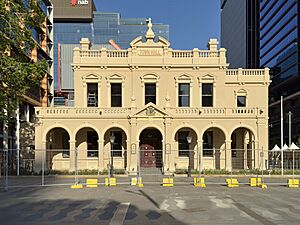
According to the 2021 census, the suburb of Parramatta had 30,211 people. Here are some facts about them:
- Where people are from: The most common country of birth in Parramatta is India, with 30.9% of the population. This is more than the number of people born in Australia (24.8%). Other common countries of birth are China (8.9%), Nepal (5.5%), Philippines (2.5%), and Iran (1.3%).
- Languages spoken at home: Only about a quarter (24.4%) of people spoke English at home. Other languages spoken include Hindi (10.4%), Mandarin (8.8%), Nepali (5.3%), Tamil (5.0%), and Telugu (4.3%).
- Religions: The most common religion is Hinduism (33.6%). Many people also reported "No Religion" (21.6%). Other common religions are Catholic (12.1%) and Islam (7.5%).
- Age: Parramatta has more young adults compared to the rest of Australia. The average age of residents was 32 years, while the national average is 38. Children under 15 made up 16.3% of the population. People aged 65 and over made up 6.6%.
- Income: The average weekly household income was $2,092. This is higher than the national average of $1,746.
- Homes: Most homes in Parramatta (85.6%) are flats, units, or apartments. Only 7.7% are separate houses. The average household size was 2.4 people.
Famous People from Parramatta
- Richie Benaud (1930–2015), a famous cricketer and commentator.
- Paul Hogan (born 1939), a well-known comedian and actor.
- Harry Hopman (1906–1985), a tennis player.
- David Lennox (1788–1873), a colonial bridge builder.
- Rev. Samuel Marsden (1765–1838), an early church leader.
Education in Parramatta
Parramatta has several schools. Arthur Phillip High School has been a school since 1875. It is the oldest public school in Parramatta that has been open continuously. Parramatta High School was the first coeducational (boys and girls together) school in Sydney. Our Lady of Mercy College is one of Australia's oldest Catholic schools. Other schools include Parramatta Public School and St Patrick's Primary Parramatta.
Several universities also have campuses in Parramatta. Western Sydney University has two campuses here. The main campus is Parramatta South, which is on the site of the historic Female Orphan School. The other is Parramatta City Campus. Alphacrucis University College is a Christian college with a campus in Parramatta. The University of Sydney has also announced plans to open a new campus in Parramatta.
Media and News
The Parramatta Advertiser is the local newspaper for Parramatta and nearby areas.
On March 16, 2020, the Australian Broadcasting Corporation (ABC) opened a new newsroom in Parramatta. This was part of their plan to have more staff outside of Central Sydney. On June 16, 2021, the ABC also announced that it plans to move about 300 employees to Parramatta. This is part of a five-year plan to have more of their content creators working away from their main office in Ultimo.
Culture and Sports
As a major center in Sydney, Parramatta hosts many festivals and events. Riverside Theatres is a performing arts center on the northern bank of the Parramatta River. The city holds events like:
- January – Sydney Festival and Australia Day
- February – Lunar New Year and Tropfest
- April – Anzac Day
- July – Winterlight and Burramatta Day (Naidoc)
- October – Parramasala and Parramatta Lanes
- November – Loy Krathong, Christmas in Parramatta and Foundation Day
- December – New Year's Eve
Parramatta Park contains Old Government House. This means Parramatta was once the capital of the New South Wales colony. Another feature is a natural outdoor theater called "the Crescent." It is used for concerts. The park is also home to the Dairy Cottage, built between 1798 and 1805. It is one of Australia's earliest surviving cottages.
The remains of Governor Brisbane's private astronomical observatory, built in 1822, can be seen. Astronomers who worked there discovered many new stars.
Cultural Events
- The Rosehill Race Course holds horse races throughout the year.
- The Parramatta Farmers Markets happen every Friday, selling local produce.
Sports Teams
Parramatta is home to several professional sports teams. These include the Parramatta Eels rugby league team and the Western Sydney Wanderers soccer team. Both teams play at the 30,000-seat Western Sydney Stadium. This stadium replaced the old Parramatta Stadium. The new stadium opened on April 14, 2019. The first big sports event was a rugby league game between the Parramatta Eels and Wests Tigers on April 22, 2019. The Eels won the game. The new stadium is expected to help the economy of Western Sydney.
Entertainment
The 2013 superhero movie The Wolverine used the intersection of George Street and Smith Street as a filming location. It was made to look like Tokyo, Japan.
Historic Places
Parramatta has many places listed for their historical importance. Here are some of them:
- 1 and 3 Barrack Lane: Warders Cottages
- 39 Campbell Street: Lennox House
- 195 Church Street: St John's Cathedral
- 349–351 (adj) Church Street: Lennox Bridge
- 353 Church Street: Prince Alfred Square
- 10 George Street: Brislington
- 65–69 George Street: Roxy Theatre
- 85 George Street: Perth House
- 88–92 George Street: 88–92 George Street
- 182 George Street: Harrisford
- Great Western railway: Parramatta railway station
- Horwood Place: Redcoats Mess House
- 1 Marist Place: Murphy House
- 45 Macquarie Street: Parramatta Archaeological Site
- Marsden Street: Parramatta Hospital Archaeological Site
- 8 Melville Street: Macarthur House
- O'Connell Street: Old King's School
- O'Connell Street: Old Government House
- 1 O'Connell Street: St John's Anglican Cemetery
- 12, 14, 16 O'Connell Street: Travellers Rest Inn
- 25 O'Connell Street: Avondale
- 40–42 O'Connell Street: Roseneath Cottage
- Corner O'Connell Street and Dunlop Street, North Parramatta: Parramatta Correctional Centre
- 54 Sorrell Street: Endrim
- 43a Thomas Street: Broughton House
Images for kids
See also
 In Spanish: Parramatta para niños
In Spanish: Parramatta para niños


